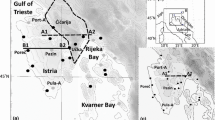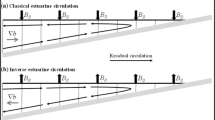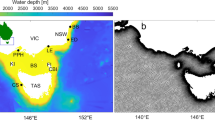Abstract
A series of numerical sensitivity experiments is performed to quantify the impact of sea-surface temperature (SST) distribution on offshore surface fluxes and simulated sea-breeze dynamics. The SST simulations of two mid-latitude sea-breeze events over coastal New England are performed using a spatially-uniform SST, as well as spatially-varying SST datasets of 32- and 1-km horizontal resolutions. Offshore surface heat and buoyancy fluxes vary in response to the SST distribution. Local sea-breeze circulations are relatively insensitive, with minimal differences in vertical structure and propagation speed among the experiments. The largest thermal perturbations are confined to the lowest 10% of the sea-breeze column due to the relatively high stability of the mid-Atlantic marine atmospheric boundary layer (ABL) suppressing vertical mixing, resulting in the depth of the marine layer remaining unchanged. Minimal impacts on the column-averaged virtual potential temperature and sea-breeze depth translates to small changes in sea-breeze propagation speed. This indicates that the use of datasets with a fine-scale SST may not produce more accurate sea-breeze simulations in highly stable marine ABL regimes, though may prove more beneficial in less stable sub-tropical environments.















Similar content being viewed by others
References
Abbs DJ, Physick WL (1992) Sea-breeze observations and modelling: a review. Aust Meteorol Mag 41:7–19
Beljaars AC (1995) The parameterization of surface fluxes in large scale models under free convection. Q J R Meteorol Soc 121:255–270
Berri GJ, Paegle J (1990) Sensitivity of local predictions to initial conditions. J Appl Meteorol 29:256–267
Blumberg AF, Pritchard DW (1997) Estimates of the transport through the East River. J Geophys Res 102:5685–5703
Bouchlaghem K, Mansour FB, Elouragini S (2007) Impact of a sea breeze event on air pollution at the Eastern Tunisian Coast. Atmos Res 86:162–172
Bowman MJ, Esaias WE (1981) Fronts, stratification, and mixing in Long Island and Block Island Sounds. J Geophys Res 86:4260–4264
Chao Y, Li Z, Farrara JD, Hung P (2009) Blending sea surface temperatures from multiple satellites and in situ observations for coastal oceans. J Atmos Ocean Technol 26:1415–1426
Clappier A, Martilli A, Grossi P, Thunis P, Pasi F, Krueger BC, Calpini B, Graziani G, van den Bergh H (2000) Effect of sea breeze on air pollution in the greater Athens area. Part I: numerical simulations and field observations. J Appl Meteorol 39:546–562
Codiga DL, Rear LV (2004) Observed tidal currents outside Block Island Sound: offshore decay and effects of estuarine outflow. J Geophys Res 109:1–19
Colby FP Jr (2004) Simulation of the New England sea breeze: the effect of grid spacing. Weather Forecast 19:277–285
Coniglio MC, Correia L Jr, March PT, Kong F (2013) Verification of convection-allowing WRF model forecasts of the planetary boundary layer using sounding observation. Weather Forecast 28:842–862
Crosman ET, Horel JD (2010) Sea and lake breezes: a review of numerical studies. Boundary-Layer Meteorol 137:1–29
Dyer AJ, Hicks BB (1970) Flux-gradient relationships in the constant flux layer. Q J R Meteorol Soc 96:715–721
Edson JB, Jampana V, Weller RA, Bigorre SP, Plueddemann AJ, Fairall CW, Miller SD, Mahrt L, Vickers D, Hersbach H (2013) On the exchange of momentum over the open ocean. J Phys Oceanogr 43:1589–1610
Ek MB, Mitchell KE, Lin Y, Rogers E, Grunmann P, Koren V, Gayno G, Tarpley JD (2003) Implementation of Noah land surface model advances in the National Centers for Environmental Protection operational mesoscale Eta model. J Geophys Res 108:8851–8866
Fairall CW, Bradley EF, Hare JE, Grachev AA, Edson JB (2003) Bulk parameterization of air-sea fluxes: updates and verification for the COARE algorithm. J Clim 16:571–591
Fovell RG (2005) Convective initiation ahead of the sea-breeze front. Mon Weather Rev 133:264–278
Fribance DB, O’Donnell J, Houk A (2013) Residual circulation in western Long Island Sound. J Geophys Res Oceans 118:4727–4745
Gibson PB, Cullen NJ (2015) Regional variability in New Zealand’s wind research linked to synoptic-scale circulation: implications for generation reliability. J Appl Meteorol Climatol 54:944–958
Godfrey JS, Beljaars ACM (1991) On the turbulent fluxes of buoyancy, heat, and moisture at the air–sea interface at low wind speeds. J Geophys Res 96:22043–22048
Hong SY, Noh Y, Dudhia J (2006) A new vertical diffusion package with an explicit treatment of entrainment processes. Mon Weather Rev 134:2318–2341
Hu X-M, Nielsen-Gammon JW, Zhang F (2010) Evaluation of three planetary boundary layer schemes in the WRF model. J Appl Meteorol 49:1831–1844
Kain JS (2004) The Kain–Fritsch convective parameterization: an update. J Appl Meteorol 43:170–181
Kain JS, Fritsch JM (1990) A one-dimensional entraining/detraining plume model and its application in convective parameterization. J Atmos Sci 47:2784–2802
Kingsmill DE (1995) Convection initiation associated with a sea-breeze front, a gust front, and their collision. Mon Weather Rev 123:2913–2933
Krogsaeter O, Reuter J (2015) Validation of boundary layer parameterization schemes in the Weather Research and Forecasting (WRF) model under the aspect of offshore wind energy applications-part II: boundary layer height and atmospheric stability. Wind Energy 18:1291–1302
LaCasse KM, Splitt ME, Lazarus SM, Lapenta WM (2008) The impact of high-resolution sea surface temperatures on the simulated nocturnal Florida marine boundary layer. Mon Weather Rev 136:1349–1372
Latimer JS, Tedesco MA, Swanson RL, Yarish C, Stacey PE, Garza C (2013) Long Island sound: prospects for the urban sea. Springer, Dordrecht, p 558
Lombardo K, Colle BA (2013) Processes controlling the structure and longevity of two quasi-linear convective systems crossing the southern New England coast. Mon Weather Rev 141:3710–3734
Lombardo K, Sinsky E, Jia Y, Whitney MM, Edson J (2016) Sensitivity of simulated sea breezes to initial conditions in complex coastal regions. Mon Weather Rev 144:1299–1320
Lu R, Turco RP (1994) Air pollutant transport in a coastal environment. Part I: two-dimensional simulations of sea-breeze and mountain effects. J Atmos Sci 51:2285–2308
Mesinger F, diMego G, Kalnay E, Mitchell K, Shafran PC, Ebisuzaki W, Jović D, Woollen J, Rogers E, Berbery EH, Ek MB, Fan Y, Grumbine R, Higgins W, Li H, Lin Y, Manikin G, Parrish D, Shi W (2006) North American regional reanalysis. Bull Am Meteorol Soc 87:343–360
Miller STK, Keim BD, Talbot RW, Mao H (2003) Sea breeze: structure, forecasting, and impacts. Rev Geophys 41:1–31
Morrison H, Thompson G, Tatarskii V (2009) Impact of cloud microphysics on the development of trailing stratiform precipitation in a simulated squall line: comparison of one and two-moment schemes. Mon Weather Rev 137:991–1007
Nakanishi M, Niino H (2006) An improved Mellor–Yamada level-3 model: its numerical stability and application to a regional prediction of advection fog. Boundary-Layer Meteorol 119:397–407
Nakanishi M, Niino H (2009) Development of an improved turbulence closure model for the atmospheric boundary layer. J Meteorol Soc Jpn 87:895–912
National Centers for Environmental Prediction/National Center for Atmospheric Research (2004) North American regional reanalysis 1. National Climatic Data Center/National Operational Model Archive and Distribution System. https://www.ncdc.noaa.gov/data-access/model-data/ model-datasets/north-american-regional-reanalysis-narr
Ngan F, Cohen M, Luke W, Ren X, Draxler R (2015) Meteorological modeling using the WRF-ARW model for Grand Bay intensive studies of atmospheric mercury. Atmosphere 6:209–233
Novak DR, Colle BA (2006) Observations of multiple sea breeze boundaries during an unseasonably warm day in metropolitan New York City. Bull Am Meteorol Soc 87:169–174
Ries H, Schlunzen KH (2009) Evaluation of a mesoscale model with different surface parameterizations and vertical resolutions for the Bay of Valencia. Mon Weather Rev 137:2646–2661
Robinson FJ, Patterson MD, Sherwood SC (2013) A numerical modeling study of the propagation of idealized sea-breeze density currents. J Atmos Sci 70:653–668
Rouault M, Lutjeharms JRE (2000) Air-sea exchange over an Agulhas eddy at the subtropical convergence. Global Atmos Ocean Syst 7:125–150
Rouault M, White SA, Reason CJC, Lutjeharms JRE, Jobard I (2002) Ocean–atmosphere interaction in the Agulhas Current Region and a South African extreme weather event. Weather Forecast 17:655–669
Sharma A, Fernando HJS, Hamlet AF, Hellmann JJ, Barlage M, Chen F (2017) Urban meteorological modeling using WRF: a sensitivity study. Int J Climatol 37:1885–1900
Simpson JE (1987) Gravity currents: in the environment and the laboratory. Wiley, New York
Simpson JE (1994) Sea breeze and local wind. Cambridge University Press, Cambridge
Skamarock WC, Klemp JB, Dudhia J, Gill DO, Marker DM, Duda MG, Huang X-Y, Wang W, Powers J (2008) A description of the advanced research WRF version 3. NCAR Tech Note NCAR/TN-4751STR
Srinivas CV, Venkatesan R, Somayaji KM, Singh AB (2006) A numerical study of sea breeze circulation observed at a tropical site Kalpakkam on the east coast of India under different synoptic flow situations. J Earth Syst Sci 115:557–574
Steele CJ, Dorling SR, von Glasow R, Bacon J (2013) Idealized WRF model sensitivity of sea breeze types and their effects on offshore windfields. Atmos Chem Phys 13:443–461
Steele CJ, Dorling SR, von Glasow R, Bacon J (2015) Modelling sea-breeze climatologies and interactions on coasts in the southern North Sea: implications for offshore wind energy. Q J R Meteorol Soc 141:1821–1835
Thompson WT, Holt T, Pullen J (2007) Investigation of a sea breeze front in an urban environment. Q J R Meteorol Soc 133:579–594
Ullman DS, Codiga DL (2004) Seasonal variation of a coastal jet in the Long Island Sound outflow region based on HF radar and Doppler current observations. J Geophys Res Oceans 109:1–15
Whitney MM, Garvine RW (2008) Estimating tidal current amplitudes outside estuaries and characterizing the zone of estuarine tidal influence. Cont Shelf Res 28:380–390
Wilson RE (1976) Gravitational circulation in Long Island Sound. Estuar Coast Mar Sci 4:443–453
Xiao C, Lofgren BM, Wang J, Chu PY (2016) Improving the lake scheme within a coupled WRF-lake model in the Laurentian Great Lakes. J Adv Model Earth Syst 8:1969–1985
Yang Y, Chen YL, Fujioka FM (2005) Numerical simulations of the island-induced circulations over the island of Hawaii during HaRP. Mon Weather Rev 133:3693–3713
Yerramilli A, Srinivas CV, Dasari HP, Tuluri F, White LD, Baham JM, Young JH, Hughes R, Patrick C, Hardy MG, Swanier SJ (2009) Simulation of atmospheric dispersion of elevated releases from point sources in Mississippi Gulf coast with different meteorological data. Int J Environ Res Public Health 6:1055–1074
Zhang Y, Chen YL, Schroeder TA, Kodama K (2005) Numerical simulations of sea-breeze circulations over northwest Hawaii. Weather Forecast 20:827–846
Acknowledgements
This research was supported by NASA ROSES (2011) Grant NNX13AE25G and University of Connecticut Grant 4197970. The authors would like to thank two anonymous reviewers, whose comments improved the quality of this manuscript.
Author information
Authors and Affiliations
Corresponding author
Appendix
Appendix
The MYNN surface-layer parametrization of the WRF model uses a bulk-flux algorithm based on the COARE 3.0 algorithm (Fairall et al. 2003) to compute the surface fluxes using a modification implemented by Dr. Joseph Olson. The COARE 3.0 algorithm relies on wind-speed dependent parametrizations of the aerodynamic roughness length
where \(\nu \) is the kinematic velocity, \(u_*\) is the friction velocity, and \(\alpha \left( U \right) \) is the wind-speed dependent Charnock parameter. The wind speed U used in the current version of the MYNN parametrization is given by the value at the lowest grid point, \(U_{a}\). Future versions of the code should change the wind speed used in Eq. 8 to the value adjusted to a height of 10 m. As with the COARE 3.0 algorithm, the current version of the MYNN parametrization adds a gustiness component to the mean wind speed computed under convective conditions, which accounts for the unsteady flow causing an appreciable flux in convective conditions not included in the mean wind speed because gusts average to zero (Godfrey and Beljaars 1991; Beljaars 1995). The parametrization is based on the convective velocity scale \(w_{*}\), which requires model estimates of the buoyancy flux and the boundary-layer height. The same parametrization is now used over land and water, which removes the old parametrization that created unrealistic values over large air–sea temperature differences.
The first term on the left-hand-side parametrizes the roughness under smooth flow (i.e. light winds), while the second term represents the roughness of the wind waves supporting the surface stress. The roughness length is used to determine the drag coefficient \(C_\mathrm{D}\), and thereby the friction velocity as
where \(\tau \) is the momentum flux at the surface or surface stress, \(\kappa \) is the von Karman constant (set to 0.4), and z is the height of the lowest grid point. The surface stress should be estimated using a wind speed relative to water (Edson et al. 2013) in which case \(U\left( {z_{0}}\right) \) represents the surface current. However, surface currents are not included here, so the friction velocity is computed using the wind speed relative to earth.
Comparison of the Dyer and Hicks (1970) and COARE 3.0 parametrizations of the stability function for wind shear. Negative values of z / L denote unstable (convective) conditions and positive reflect stably stratified conditions
The function \(\psi _{m}\left( {z/L}\right) \) accounts for modulation of the logarithmic wind-speed profile due to atmospheric stability, where L is the Obukhov length. The default parametrization of the stability functions is based on Dyer and Hicks (1970), which differs from the COARE 3.0 parametrization shown in Fig. 16, where the difference is most notable in very stable conditions. The current version in the MYNN parametrization places limits on the value of the Obukhov length as \(-10<\,z{/}L\,<\,2\).
The roughness length and friction velocity are then solved iteratively. The thermal and moisture roughness lengths are parametrized as the same function of the roughness Reynolds number \(\frac{z_{0}u_{*}}{\nu }\), i.e. \(z_{t}=z_{q}=f\left( {\frac{z_{0}u_{*}}{\nu }}\right) \), which are used to calculate the transfer coefficients for heat and moisture for the computation of the sensible and latent heat fluxes in Eqs. 1 and 2, respectively, as
Here, \(\psi _{t}\) is a function that parametrizes the effect of stability on the potential-temperature gradient and is assumed equal to the function that accounts for this effect on the mixing ratio (or specific humidity). The fluxes are used to define the Obukhov length as
where \(T_{*}\equiv -\left( {\frac{H}{\rho c_\mathrm{p}}}\right) /u_{*}\), and represents the scaling parameter for temperature in Monin–Obukhov similarity theory.
A shortcoming of this definition of the Obukhov length is that it does not account for the contribution of the moisture flux to the buoyancy flux, which is required for the convective velocity scale (which is correctly defined in the MYNN parametrization) and is included by adding the scaling parameter for humidity
where \(q_{*} \equiv -\left( {\frac{\lambda _{E}}{\rho \lambda }} \right) /u_{*}\) and the buoyancy flux is given by \(u_{*} (T_{*} +0.61\theta _{g} q_{*})\) in kinematic units. The moisture flux generally increases the buoyancy over the ocean and can actually overwhelm the temperature stratification, making the surface layer unstable and mixing more efficient. Under conditions of very small surface heat fluxes, the exclusion of the moisture flux tends to incorrectly diagnose the surface layer as being too stable. This shortcoming is an avenue of research that is currently being pursued.
The MYNN parametrization calculates the 2-m temperature and mixing ratio, and the 10-m wind speed as diagnostic variables, which are derived using semi-logarithmic profiles with the same stability functions used for the transfer coefficients. For example, the potential temperature at 2 m is defined as
and is combined with the expression for the potential temperature at the first grid point,
to eliminate the scaling parameter, giving
which removes the stability correction in neutral conditions. Similar expressions are used for the 2-m mixing ratio (or specific humidity) and 10-m wind speed as
and
respectively, where \(U_{g}\) again represents the surface current and is set to zero here.
Rights and permissions
About this article
Cite this article
Lombardo, K., Sinsky, E., Edson, J. et al. Sensitivity of Offshore Surface Fluxes and Sea Breezes to the Spatial Distribution of Sea-Surface Temperature. Boundary-Layer Meteorol 166, 475–502 (2018). https://doi.org/10.1007/s10546-017-0313-7
Received:
Accepted:
Published:
Issue Date:
DOI: https://doi.org/10.1007/s10546-017-0313-7





